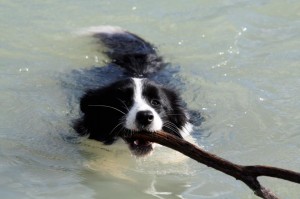McGreevy and Non-Associative Learning
This post is part of the McGreevy seminar series. Click here for the index.
Paul McGreevy spoke a little about non-associative forms of learning. I found these particularly interesting, as I have not actively considered these forms of learning before, let alone attended a seminar about them! Though I had heard of habituation and sensitisation before, McGreevy clarified and solidified my prior understanding.
Mostly, the seminar considered classical and operant conditioining. In both of these forms of learning, an association is made between one thing and another. For example, if a dog hears the fridge open, they associate this with food, and start salivating. Similarly, a dog may associate the action of sitting with a toy reward.
However, training can also be non-associative. Non associative learning uses a single stimuli (i.e. ‘thing’, trigger). The two forms of non-associative learning, as McGreevy put it, are habituation and sensitisation.
Habituation
Habituation is the simplest form of learning. When an animal is repeatedly exposed to a stimuli, and their response decreases on each exposure, then they are habituating to the stimuli.
For example, a dog may startle at the sound of a door slamming shut in the wind initially. However, as this occurs once or twice a day, the dog begins to startle less and, eventually, barely responds to the door slams. This dog has been habituated to the door slamming noise.
Habituation can occur at different rates. It depends on the stimulus, the frequency of presentation, and the regularity of exposure.
The stimulus itself can be benign or more alarming. For example, a rock on the ground is less alarming than a bag blowing in the wind. In this way, the nature of the stimulus (i.e. the stimulus itself) can affect the likelihood of habituation taking place, with ‘boring’ stimuli more likely to be habituated to.
The frequency of presentation of the stimulus can also the rate of habituation. Clearly, if an animal was exposed only once to an aversive stimuli, they are unlikely to reduce their response in subsequent exposures. For example, some dogs are alarmed by the smell of predators, like foxes. A dog exposed to fox smell may at first respond in a hyper-aroused or anxious way. However, over time, the dog may begin to habituate to the smell of a fox if it was frequent (for example, if the dog was frequently walked along a route with fox smell).
Finally, the regularity of exposure is important. If an animal is exposed to a stimulus only once a year or once every few months, it is unlikely to habituate. For example, if the exposure was daily, then they are more likely to habituate to the phenomena. McGreevy made reference to puppy schools, and how they normally happen on an irregular basis (i.e. once a week) and this is not enough for puppies to become habituated to people and other dogs.
Sensitisation
Sensitisation, on the other hand, is the opposite of habiutitation. During sensitisation, the animal responds more to a stimulus after repeated exposure. In this case, the stimulus itself has to be intrinsically aversive. For example, dogs who are scared of thunderstorms can often get more fearful over time.
Our next posts in the McGreevy series will look at Classical Conditioning.
Further reading: Dogs deciding whether something is important or not?
This post is part of the McGreevy seminar series. Click here for the index.

